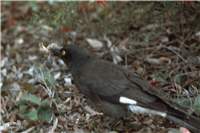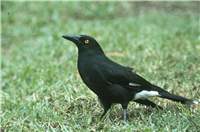Family
Artamidae
Genus
Strepera
Species
graculina
Threats/Control Methods - Regional
The Pied Currawong threatens agriculture and native plant species through its tendency to eat and spread the seeds and fruits of invasive weeds. It also directly threatens other bird species through hunting. In NSW, full and partial removal of the species has lead to the improvement of population numbers of endangered bird species.
Threats/Control Methods - Local
No local control methods are currently taking place.
Local/Urban Actions
Suburban gardeners should avoid keeping weed species, as they encourage Pied Currawongs to carry the fruits and seeds to other areas, contributing to Australia's current weed problems. Reducing the quantities of exotic berry-producing plants, such as privets and Asparagus Fern (Asparagus densiflorus) will be especially helpful in keeping Currawong numbers down.
Common Names
Pied Currawong, Currawong, Bell Magpie, Black Magpie, Chillawong, Mountain Magpie
Distinguishing Features
The Pied Currawong is a large, mostly black bird, with a bright yellow eye. There is a white crescent patch on the wing and white on the rump and tail tip. It has a strong black bill with a slight hook. Young Pied Currawongs are duller and browner than the adults.
Survey Techniques
Call and visual identification.
Species Call
A loud, gurgling "curra-currow-currowk". Other sounds include deep croaks and a wolf whistle.
Similar Species
The Grey Currawong (Strepera fuliginosa) is also found in the ACT and is very similar in shape, being more grey in colour and lacking the white on the rump. The Australian Magpie (Gymnorhina tibicen ) can also be confused with the Currawong, however it is smaller in size and has much larger areas of white on its plumage, notably around the head and neck. The Magpie also has a red-brown eye.
Distribution
It is found right across Eastern Australia from far north Queensland to Victoria, excluding Tasmania.
Country of Origin
Australia
Conservation (Pet/Pest) Status - Regional
There has been a steady increase of birds in the region over summer (the breeding time of many other birds) potentially hindering the ability of other birds to breed successfully.
Conservation (Pet/Pest) Status - National
Secure, not listed under the EPBC Act 1999. Across NSW, attempts have been made to control the growing population numbers to protect other bird species.
The Pied Currawong of western VIC (Strepera graculina ashbyi) is critically endangered due to hybridization. The small and restricted population of Lord Howe Island (Strepera graculina crissalis) is listed as endangered.
LSCCES Population
In the LSCCES the species was abundant across the entire catchment with numbers highest in suburban Turner.
Associated vegetation community
Pied Currawongs are originally forest dwellers, however they have adapted well to urban environments.
Limiting Resources
This species has adapted extremely well to the urban environment. Being able to use a wide range of urban food and shelter resources means its survival is not limited. Its campacity to thrive in urban gardens in the ACT and its habit of predating on smaller bird species has seen the species implicated in the decline of native species, thought this has been disputed (see references).
Breeding
Across the Canberra region, the species' nest building commences in July, peaks in August and finishes by November. A complete breeding event for one pair takes about 15 weeks, with a typical clutch size of 3, needing 21 days of incubation and around 30 days in the nest.
Behaviour
The species used to move out of Canberra during the summer to breed in the forests, however now the birds have become a very common breeding species within Canberra gardens. They can form large, noisy conspicuous flocks that wander nomadically over large distances. They are bold scavengers, often seen around rubbish in the suburbs.
Functional Group
Food Species
The Pied Currawong is a known predator of the eggs and young of other birds breeding in the Canberra region, particularly towards Suburb Fairy-wrens (Malurus cyaneus ), Common Starlings (Sternus vulgaris) and Common Blackbirds (Turdus merula ). If hunting in packs, they can eat young Brushtail possums (Trichosurus vulpecula) and lizards, but usually eat insects, caterpillars and berries.
Predators
This species is not vulnerable to attacks from other species and instead is a major predator of other smaller birds.
Interesting Fact
This species can cause problems for the survival of small birds during its breeding season, as a pair of Pied Currawong may kill about 40 broods (up to two kilograms) of small birds to raise one brood of its own.
References - (reader suitability of references, P=Primary teachers, S=Secondary students, T=Tertiary students and researchers)
Books:Morcomber, M. 2000. Field guide to Australian Birds. Steve Parish Publishing, Archerfield. P, S, T
Schodde, R. and Tideman, S. (eds) 1990. Reader's Digest Complete Book of Australian Birds (2nd Edition). Reader's Digest Services Pty Ltd. Sydney. P, S, T
Veerman, P. 2003. Canberra Birds: A report on the first 21 years of the garden bird survey. Philip Veerman and Canberra Ornithologists Group. Canberra. S, T
Internet: Birds in Backyards. 2006. Birds Behaving Badly - Pied Currawong. Australian Museum. [online]. Available at:http://birdsinbackyards.net/feature/birds-behaving-badly-currawong.cfm P, S, T
Canberra Ornithological Group (COG). 2004. Birds of Canberra Gardens. COG and the ACT Department of Urban Services. [online]. Available at:http://garden.canberrabirds.org.au/ P, S, T
Garnett, S. and Crowley, M. 2000. The Action Plan for Australian Birds 2000. Department of Environment and Water Resources. [online]. Available at: http://www.deh.gov.au/biodiversity/threatened/publications/action/birds2000/index.html S, T
Online Publications:Bayly, K. L. & Blumstein, D. T. 2001. Pied Currawong and the decline of native birds. Emu, 2001, 101, p 199-204. Available at: http://www.eeb.ucla.edu/Faculty/Blumstein/pdf%20reprints/Bayly&Blumstein2001_Emu.pdf.
Nix, H. and Cunningham, R. 2006. Birds of the Lower Sullivans Creek Catchment, Canberra ACT. Prepared for the Life in the Suburbs project using data from the Lower Sullivans Creek Catchment Ecological Survey (LSCCES). Australian National University. Canberra. [online]. Available at: http://www.lifeinthesuburbs.com.au/category.php?id=65 S, T
Olsen, P. et al. 2005. The State of Australia's Birds 2006: Invasive Species. Supplement to Wingspan 16:4. Birds Australia. [online]. Available at: http://www.birdsaustralia.com.au/soab/SOAB2006.pdf S, T



 Top
Top Top
Top